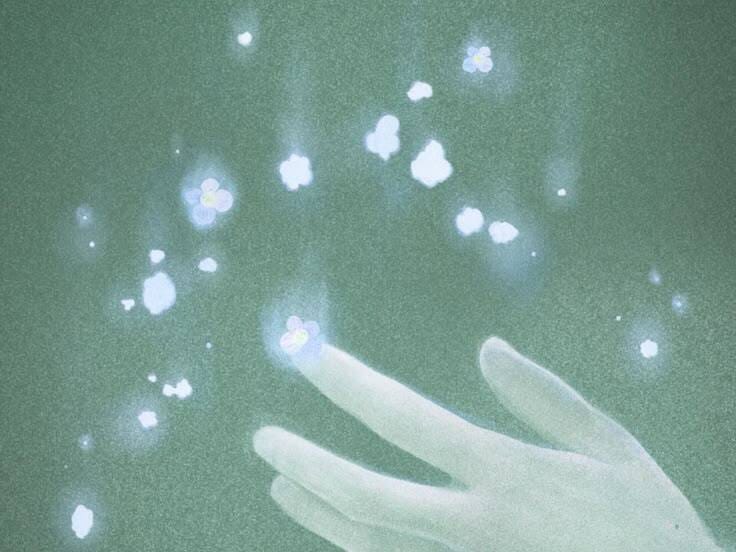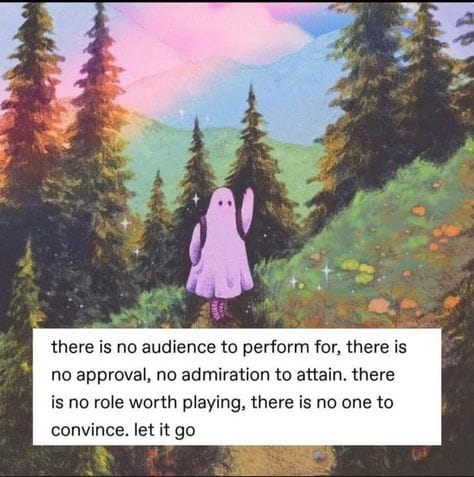- Artifacts of Being
- Posts
- The Teachings of Your Blood
The Teachings of Your Blood
The most common form of despair is not being who you are. — Søren Kierkegaard

Mr. Rogers said:
You rarely have time for everything you want in this life, so you need to make choices. And hopefully your choices can come from a deep sense of who you are.
How do you get a deep sense of who you are?

Here’s a preview of where we’re headed:
There is a voice inside of you that whispers all day long, ‘I feel that this is right for me, I know that that is wrong.’ No teacher, preacher, parent, friend, or wise man can decide what’s right for you—just listen to the voice that speaks inside.
— Shel SilversteinI was one who seeks, and I still am, but I no longer seek in the stars or in books; I'm beginning to hear the teachings of my blood pulsing within me.
— Hermann HesseIf you bring forth what is within you, what you bring forth will save you. If you do not bring forth what is within you, what you do not bring forth will destroy you.
— Gospel of Thomas
1. Drop all efforts | Practice from Sam Harris
In his guided meditations, Sam Harris often gives a simple instruction: “Drop all efforts.” When I hear this, my shoulders drop, my face relaxes, and I feel like myself. If I was trying to be something, I stop. The reminder cuts through whatever I’m forcing—as does the Chinese proverb, "tension is who you think you should be; relaxation is who you are.” |  |
I’m convinced that one of the most important projects in life is to become more honest with yourself about what’s happening inside of you, and to not look away. If you continually cultivate a true familiarity with yourself, and act from that authentic center, what more could you ask from yourself? Or for yourself?
Try right now. Drop all efforts.
2. Exercise internal discernment | Practice from mindfulness traditions
A few years ago, a Buddhist therapist encouraged me to build the muscle of listening to my intuition. He’d say:
Bring to mind a decision you’re facing.
Frame it as a choice between two paths.
Close your eyes and vividly imagine one path.
Then, vividly imagine the other path.
Where do you feel more open? More joy, peace, ease, love?
The practice is learning to hear a whisper.
 @_dagou | Parker J. Palmer explains the nature of this listening: "The soul speaks its truth only under quiet, inviting, and trustworthy conditions. The soul is like a wild animal—tough, resilient, savvy, self-sufficient, and yet exceedingly shy. If we want to see a wild animal, the last thing we should do is to go crashing through the woods, shouting for the creature to come out. But if we are willing to walk quietly into the woods and sit silently for an hour or two at the base of a tree, the creature we are waiting for may well emerge, and out of the corner of an eye we will catch a glimpse of the precious wildness we seek.” |
The precious wildness usually doesn’t let out a pronounced roar—it makes itself known in subtle shifts, subtle calls. What could be more worth listening to?
3. Feel your way through problems | Practice from Joe Hudson
“If you can't seem to solve a problem in your life, you probably don't need to think about it more. You need to feel about it more.”
When I’m facing a problem, my instinct is to think about it harder: What caused this situation? What does it mean? What does it say about me? Where does that come from? Where might it lead?
What I'm not doing is processing my emotion. I’m bypassing the raw feelings and spinning up narratives instead.
When I heard this idea from Joe, I began to focus on my felt experiences rather than my interpretations—on feeling deeper1 rather than thinking harder.
Basically, I try to look for the tenderness—the discomfort, pain, snag—and to sit with it. Uncomfortably. When something unlocks, I ask again: now where is the tenderness?
Eventually, I hear my core conflict. And one of two things happens:
I feel resolution. (Ah. Now that I’ve felt this fully, I see that there’s no problem. I feel safe.)
I gain clarity about my next step. (Ah. Now that I’ve felt this fully, I see that the crux of the tension is actually [here], and I need to talk about/reflect on/act on [this].)
Feeling reveals what actually matters to me, and what action is truest.
4. Locate the tension | Inner landscape practice
At the beginning of 2025, I did an exercise2 that changed the trajectory of my year:
I listed the key areas3 of my life.
I gave each area a brief description that felt authentic to me.
For each area, I asked myself as honestly and unconditionally as I could:
Where do I have tension?
Where do I feel cognitive dissonance?
Where would I like to be doing better?
What’s causing stress or uncertainty?
Where do I feel stuck or unresolved?
I didn’t think about what to do. I just took inventory and tried to be radically transparent with myself.
I gave myself hours to do this—to clear out the cobwebs, name the tensions, and surface the aspirations in my head and my heart.4
In hindsight, the most powerful part wasn’t what came next (setting goals). It was simply giving myself the space to name and process the full range of what I think, feel, and feel about my thinking and feeling. Not trying to solve, but to see. To honor my inner experience with attention.
For me, the process:
built clarity (revealed the directions I’m pulled in, which reduced fog)
surfaced root issues (what’s actually driving discomfort)
built self-compassion (seeing underlying tensions led to self-understanding and softening)
built the foundation for wise action (when clear about what’s actually going on, actions feel more grounded and intentional)

@_dagou
5. Live by your inner guide | Song: My Way by Frank Sinatra
The first time I heard this song, I felt an instant, deep reverence for it. It felt like the intuitive answer to the core human question: what will guide your life? I committed to living my life by it.
As Mary Oliver says—"you must not, ever, give anyone else the responsibility of your life." I want to be driven by my deepest self, weird and unabashed. To be dropped into who I am as much as possible. To be free!
Occasionally, I hear the song out in the real world and it feels like the universe saying:
keep taking the risk of authenticity.
In the summer of 2022, after a perfect day wandering the streets of Paris, I stopped by the Louvre as the sun was setting. I’d recently ended a relationship, which felt like stepping off of the conventional path of life, and everything felt uncertain. When this man started playing My Way, my spirit overflowed. I sat on the steps for hours, in gratitude. |
It can feel like we’re dropped into life with no instructions, left yearning for guidance on how to live. And maybe our inner experience—if we can learn to listen to it—is our most reliable guide. Even the best external guidance is processed through our own filter, and I want to build the muscle of hearing my filter—not just my mind, which can talk me in and out of anything, and distract me from what actually feels good, safe, and right. I can reason my way to a perfect plan, but if my gut says no, if my nervous system contracts, if it doesn’t land right in my body, then the verdict is in. My filter is the final test; my body holds the final vote.
As you become more rooted inside—as you drink from this silent stream of life that runs beneath the surface of everything—as you live from that depth of your own being more and more, then you’ll be able to rise taller and stronger in this world; more than you may have ever thought possible.
— Derek Ryda
1 Recall the sensation of thinking a thought all the way through. Now what about feeling a feeling all the way through?
2 The exercise was borne of frustration. I wrote to myself:
It feels like I have an endless list of things I want to change about my life—and a corresponding number of ideas about how to change. I am desperate to see the landscape—to wrap my arms around all that matters to me, all of my ambitions, all I wish I was doing, and to get clear on my priorities. To be emptied of loose aspirations.
3 I was tempted to come up with a perfect categorization system, and list out every single possible important area, but I challenged myself to get it 90% right and begin. If I missed a category, I could add it later.
4 This was enormously relieving. So many of our beliefs, desires, and capabilities stay buried in our minds, and documenting them gives breath to genuine parts of ourselves that, for now, exist only as potential.
”The very least you can do in your life is to figure out what you hope for. And the most you can do is live inside that hope . . . running down its hallway and touching the walls on both sides.” — Barbara Kingsolver